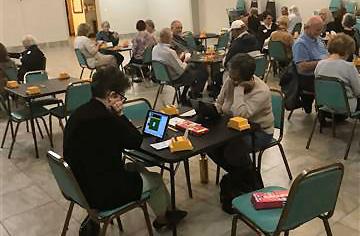
Bonnie and Angela take on the robot pair.
Photo by Roy Wilson, April 2018
Roy's article on the Unit web site here
Last week was our first trial-run for having a pair of BBO (BridgeBase Online) robots fill a half-table at the BridgeMojo game.
What's wrong with having a sit-out?
Normally when the game has a half-table, on every round there's a pair who can't play. That pair has a 15-minute break. For the BridgeMojo game, that means seven pairs in the game will play twelve boards, and the rest will play fourteen.
To compensate for the difference, the total matchpoint score for those pairs is factored before comparing it with the other pairs in the game. Their final score is multiplied by 14/12 (7/6, 1.166). (Remember your fractions?) That brings every player up to a common baseline score.
That's not really a bad thing, it's just a fact of the game. The same thing happens when some boards don't get to be played as many times as others. If you can't play a board for some unavoidable reason, the director records the score as a "No play." Your final result will be factored to match the field, and the matchpoints for that board will be factored for the other players as well.
When this happens, there's no "penalty" for not playing a board — your final score is based on fewer boards than the rest of the field.
Mostly it's a mild disappointment for players who came to play bridge, and now get a bit less bridge than expected.
BridgeBase Online has been offering games with robot players for years now. The robots are pretty good, and entertaining to play against. ACBL has held two "NABC Online Individual" tournaments, where every player has a robot partner and opponents. (I did reasonably well in the second one with a 57.74% after 72 hands, ranked 255 out of 1,914 entries.)
Several enterprising club directors have been practicing the methods for doing this. Jay Whipple, who is now president of the ACBL and the technologist behind The Common Game, has been building tools for directors to help set up the hands for the robot table.
(I'll save the "how to" for another article. It all gets a little involved!)
Last Monday, April 2, 2018, was our first game to play with one robot pair. I set up Table 10 with a pair of Apple iPads on tablet stands. Seven East/West pairs sat down to play the same two boards they would have played in the round against invisible opponents.
So how did they do?
The robots are ineligible for masterpoints, of course, much like if I play in the game to fill a table. If they had been eligible, they would have placed second N/S with a 55.56% game.
The real question is, "Did the robots affect the standings of the human players?" The short answer is "no!" Most pairs had very normal bridge results against the robots. Some got very good results, some not so good, including some tops and bottoms.
To test the results, I took out all of the scores that were played against the robot opponents, and rescored the game as if that had been a sit-out round.
The differences in scores were tiny, some going slightly up, some slightly down. The final standings (1st, 2nd, etc.) were all identical with the exception of one pair. That pair had an unlucky round against the robots, and taking out that round improved their score enough to tie a scratch.
To me this was a normal bridge result! I always have "that one round" where if I hadn't played I would have had a better result.
It all takes a little getting used to. The robots bid and play very quickly (we humans decide pretty slowly!). The interface is unfamiliar. All of those things will fall by the wayside soon enough.
For now, I will offer an "opt-out," if players would prefer not to play the robot round. Their score will be based on 12 boards instead of 14, just like a normal sit-out round. It becomes another "risk/reward" decision — risking giving up a potential good result for a potential bad one.
